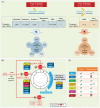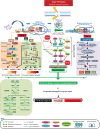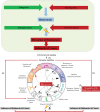Integrating the DNA damage and protein stress responses during cancer development and treatment
- PMID: 29756349
- PMCID: PMC6120562
- DOI: 10.1002/path.5097
Integrating the DNA damage and protein stress responses during cancer development and treatment
Abstract
During evolution, cells have developed a wide spectrum of stress response modules to ensure homeostasis. The genome and proteome damage response pathways constitute the pillars of this interwoven 'defensive' network. Consequently, the deregulation of these pathways correlates with ageing and various pathophysiological states, including cancer. In the present review, we highlight: (1) the structure of the genome and proteome damage response pathways; (2) their functional crosstalk; and (3) the conditions under which they predispose to cancer. Within this context, we emphasize the role of oncogene-induced DNA damage as a driving force that shapes the cellular landscape for the emergence of the various hallmarks of cancer. We also discuss potential means to exploit key cancer-related alterations of the genome and proteome damage response pathways in order to develop novel efficient therapeutic modalities. © 2018 The Authors. The Journal of Pathology published by John Wiley & Sons Ltd on behalf of Pathological Society of Great Britain and Ireland.
Keywords: DNA damage response; cancer; homeostasis; oncogenes; proteome damage response; replication stress; stress response; tumor suppressors.
© 2018 The Authors. The Journal of Pathology published by John Wiley & Sons Ltd on behalf of Pathological Society of Great Britain and Ireland.
Figures





References
-
- Report on Carcinogens . 2016. Available from: https://ntp.niehs.nih.gov/pubhealth/roc/index-1.html
-
- Wolfe J. Cellular Thermodynamics: the Molecular and Macroscopic Views. eLS: Wiley, 2001.
-
- Nesse RM, Bhatnagar S, Young EA. Evolutionary origins and functions of the stress response In Encyclopedia of Stress. Elsevier: San Diego, 2010; 965–970.
Publication types
MeSH terms
Substances
LinkOut - more resources
Full Text Sources
Other Literature Sources
Molecular Biology Databases

